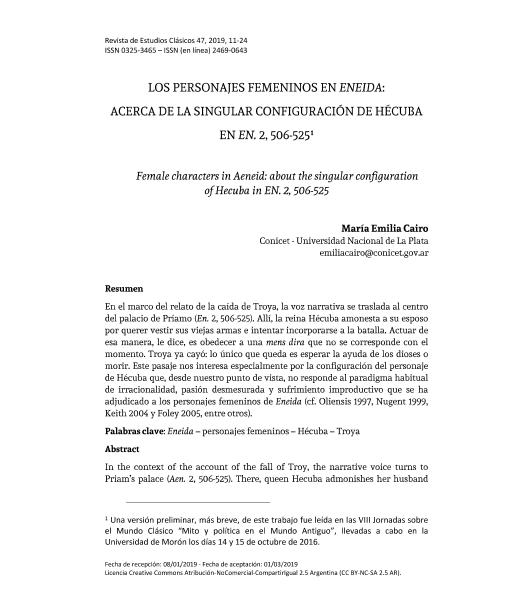Mostrar el registro sencillo del ítem
dc.contributor.author
Cairo, María Emilia

dc.date.available
2022-02-23T19:45:01Z
dc.date.issued
2019-11-29
dc.identifier.citation
Cairo, María Emilia; Los personajes femeninos en Eneida: Acerca de la singular configuración de Hécuba en EN. 2, 506-525; Universidad Nacional de Cuyo; Revista de Estudios Clásicos; 47; 29-11-2019; 11-24
dc.identifier.issn
0325-3465
dc.identifier.uri
http://hdl.handle.net/11336/152621
dc.description.abstract
En el marco del relato de la caída de Troya, la voz narrativa se traslada al centro del palacio de Príamo (En. 2, 506-525). Allí, la reina Hécuba amonesta a su esposo por querer vestir sus viejas armas e intentar incorporarse a la batalla. Actuar de esa manera, le dice, es obedecer a una mens dira que no se corresponde con el momento. Troya ya cayó: lo único que queda es esperar la ayuda de los dioses o morir. Este pasaje nos interesa especialmente por la configuración del personaje de Hécuba que, desde nuestro punto de vista, no responde al paradigma habitual de irracionalidad, pasión desmesurada y sufrimiento improductivo que se ha adjudicado a los personajes femeninos de Eneida (cf. Oliensis 1997, Nugent 1999, Keith 2004 y Foley 2005, entre otros).
dc.description.abstract
In the context of the account of the fall of Troy, the narrative voice turns to Priam’s palace (Aen. 2, 506-525). There, queen Hecuba admonishes her husband for willing to wear his old armor and trying to join the battle. To act in that way, she tells him, is to obey to a mens dira which is not appropriate for those circumstances. Troy has already fallen: the only thing that remains is either to hope for the gods’ help or to die. We consider this passage especially interesting for the configuration of Hecuba’s character, which from our viewpoint does not meet the usual paradigm of irrationality, excessive passion and unproductive suffering usually adjudicated to female characters in the Aeneid (cf. Oliensis 1997, Nugent 1999, Keith 2004 and Foley 2005, among others).
dc.format
application/pdf
dc.language.iso
spa
dc.publisher
Universidad Nacional de Cuyo

dc.rights
info:eu-repo/semantics/openAccess
dc.rights.uri
https://creativecommons.org/licenses/by-nc-sa/2.5/ar/
dc.subject
ENEIDA
dc.subject
PERSONAJES FEMENINOS
dc.subject
HECUBA
dc.subject
TROYA
dc.subject.classification
Literaturas Específicas

dc.subject.classification
Lengua y Literatura

dc.subject.classification
HUMANIDADES

dc.title
Los personajes femeninos en Eneida: Acerca de la singular configuración de Hécuba en EN. 2, 506-525
dc.title
Female characters in Aeneid: About the singular configuration of Hecuba in EN. 2, 506-525
dc.type
info:eu-repo/semantics/article
dc.type
info:ar-repo/semantics/artículo
dc.type
info:eu-repo/semantics/publishedVersion
dc.date.updated
2021-01-06T15:29:18Z
dc.identifier.eissn
2469-0643
dc.journal.volume
47
dc.journal.pagination
11-24
dc.journal.pais
Argentina

dc.journal.ciudad
Mendoza
dc.description.fil
Fil: Cairo, María Emilia. Consejo Nacional de Investigaciones Científicas y Técnicas. Centro Científico Tecnológico Conicet - La Plata. Instituto de Investigaciones en Humanidades y Ciencias Sociales. Universidad Nacional de La Plata. Facultad de Humanidades y Ciencias de la Educación. Instituto de Investigaciones en Humanidades y Ciencias Sociales; Argentina
dc.journal.title
Revista de Estudios Clásicos
dc.relation.alternativeid
info:eu-repo/semantics/altIdentifier/url/http://revistas.uncu.edu.ar/ojs/index.php/revistaestudiosclasicos/article/view/2629
Archivos asociados
